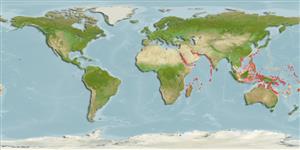Teleostei (teleosts) >
Eupercaria/misc (Various families in series Eupercaria) >
Labridae (Wrasses) > Corinae
Etymology: Stethojulis: Greek, stetho, stethion = brest; literal = to prick a little breast + Greek, ioulis, a fish dealing with genera Coris or Thalassoma (Ref. 45335).
More on author: Bonnaterre.
Environment: milieu / climate zone / depth range / distribution range
Ecology
Marine; reef-associated; non-migratory; depth range 2 - 15 m (Ref. 90102). Tropical
Western Indian Ocean: Red Sea to Natal, South Africa and east to Maldives and Chagos Islands.
Size / Weight / Age
Maturity: Lm ? range ? - ? cm
Max length : 14.0 cm TL male/unsexed; (Ref. 48636)
Inhabits reef flats and clear lagoon and seaward reefs (Ref. 9710). Found singly or in small groups consisting of one male and a few females (Ref. 9710). Feeds on small invertebrates, especially crustaceans and mollusks.
Life cycle and mating behavior
Maturities | Reproduction | Spawnings | Egg(s) | Fecundities | Larvae
Oviparous, distinct pairing during breeding (Ref. 205).
Randall, J.E., 2000. Revision of the Indo-Pacific labrid fishes of the genus Stethojulis, with descriptions of two new species. Indo-Pac. Fish. (31):42 p. (Ref. 36378)
IUCN Red List Status (Ref. 130435)
Threat to humans
Harmless
Human uses
Fisheries: commercial; aquarium: commercial
Tools
Special reports
Download XML
Internet sources
Estimates based on models
Preferred temperature (Ref.
123201): 24.9 - 29.3, mean 27.5 °C (based on 1379 cells).
Phylogenetic diversity index (Ref.
82804): PD
50 = 0.5010 [Uniqueness, from 0.5 = low to 2.0 = high].
Bayesian length-weight: a=0.00977 (0.00558 - 0.01710), b=3.07 (2.92 - 3.22), in cm total length, based on LWR estimates for this species & Genus-body shape (Ref.
93245).
Trophic level (Ref.
69278): 3.6 ±0.50 se; based on food items.
Generation time: 0.9 ( na - na) years. Estimated as median ln(3)/K based on 1
growth studies.
Resilience (Ref.
120179): High, minimum population doubling time less than 15 months (K>1).
Fishing Vulnerability (Ref.
59153): Low vulnerability (12 of 100).
Nutrients (Ref.
124155): Calcium = 118 [69, 219] mg/100g; Iron = 0.95 [0.52, 1.75] mg/100g; Protein = 18.7 [15.8, 20.9] %; Omega3 = 0.153 [0.093, 0.252] g/100g; Selenium = 25.6 [14.2, 49.0] μg/100g; VitaminA = 94.1 [29.6, 359.9] μg/100g; Zinc = 1.89 [1.23, 2.94] mg/100g (wet weight);
